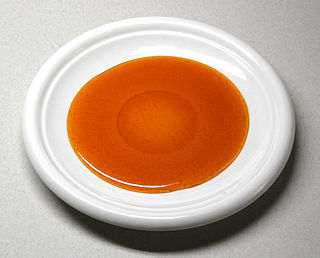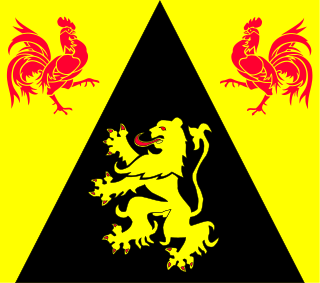
A Babelutte is a sort of long toffee flavoured with honey or vergeoise (demerara sugar) from Veurne, in Westhoek (West Flanders, Belgium). [1] The candy is closely related to Butterscotch.

A Babelutte is a sort of long toffee flavoured with honey or vergeoise (demerara sugar) from Veurne, in Westhoek (West Flanders, Belgium). [1] The candy is closely related to Butterscotch.
The name is likely to come from the Flemish "babbelen", speaking a lot, and "uit", finished because when you eat the toffee, you cannot speak anymore (either because you are enjoying it or because you cannot open the mouth). An opposing but similar explanation attributes the origin of the word to "babbelle" (which means "chatty" in Ch'ti).
The candy originates from the 19th century, from a couple that prepared and sold it to tourists on Belgian coastal beaches. [2]
The Babelutte de Lille is a famous babelutte in the Nord-Pas-de-Calais.
Moeder Babelutte is a small chain of shops in western Flanders that purveys babelutte, along with other sweets. [2]

Belgium, officially the Kingdom of Belgium, is a country in Northwestern Europe. The country is bordered by the Netherlands to the north, Germany to the east, Luxembourg to the southeast, France to the southwest, and the North Sea to the northwest. It covers an area of 30,528 km2 (11,787 sq mi) and has a population of more than 11.5 million, making it the 22nd most densely populated country in the world and the 6th most densely populated country in Europe, with a density of 376/km2 (970/sq mi). Belgium is part of an area known as the Low Countries, historically a somewhat larger region than the Benelux group of states, as it also included parts of northern France. The capital and largest city is Brussels; other major cities are Antwerp, Ghent, Charleroi, Liège, Bruges, Namur, and Leuven.

Flanders is the Dutch-speaking northern portion of Belgium and one of the communities, regions and language areas of Belgium. However, there are several overlapping definitions, including ones related to culture, language, politics, and history, and sometimes involving neighbouring countries. The demonym associated with Flanders is Fleming, while the corresponding adjective is Flemish. The official capital of Flanders is the City of Brussels, although the Brussels-Capital Region that includes it has an independent regional government. The powers of the government of Flanders consist, among others, of economic affairs in the Flemish Region and the community aspects of Flanders life in Brussels, such as Flemish culture and education.

Walloons are a Gallo-Romance ethnic group native to Wallonia and the immediate adjacent regions of France, Germany, Luxembourg and the Netherlands. Walloons primarily speak langues d'oïl such as Belgian French, Picard and Walloon. Walloons are historically and primarily Roman Catholic.

Belgium is a constitutional, hereditary and popular monarchy. The monarch is titled King of the Belgians and serves as the country's head of state and commander-in-chief of the Belgian Armed Forces. There have been seven Belgian monarchs since independence in 1830.

Caramel is an orange-brown confectionery product made by heating a range of sugars. It can be used as a flavoring in puddings and desserts, as a filling in bonbons, or as a topping for ice cream and custard.

Walloon Brabant is a province located in Belgium's French-speaking region of Wallonia. It borders on the province of Flemish Brabant and the provinces of Liège, Namur and Hainaut. Walloon Brabant's capital and largest city is Wavre.

The Flemish Movement is an umbrella term which encompasses various political groups in the Belgian region of Flanders and, less commonly, in French Flanders. Ideologically, it encompasses groups which have sought to promote Flemish culture and the Dutch language as well as those seeking greater political autonomy for Flanders within Belgium. It also encompassed nationalists who seek the secession of Flanders from Belgium, either through outright independence or unification with the Netherlands.

In Belgium, the French Community refers to one of the three constituent constitutional linguistic communities. Since 2011, the French Community has used the name Wallonia-Brussels Federation, which is controversial because its name in the Belgian constitution has not changed and because it is seen as a political statement. The name "French Community" refers to Francophone Belgians, and not to French people residing in Belgium. As such, the French Community of Belgium is sometimes rendered in English as "the French-speaking Community of Belgium" for clarity, in analogy to the German-speaking Community of Belgium.

The Flemish Region, usually simply referred to as Flanders is one of the three regions of Belgium—alongside the Walloon Region and the Brussels-Capital Region. Covering the northern portion of the country, the Flemish Region is primarily Dutch-speaking. With an area of 13,522 km2 (5,221 sq mi), it accounts for only 45% of Belgium's territory, but 57% of its population. It is one of the most densely populated regions of Europe with around 490/km2 (1,300/sq mi).

Toffee is a confection made by caramelizing sugar or molasses along with butter, and occasionally flour. The mixture is heated until its temperature reaches the hard crack stage of 149 to 154 °C. While being prepared, toffee is sometimes mixed with nuts or raisins.

There are 27 municipalities with language facilities in Belgium which must offer linguistic services to residents in Dutch, French, or German in addition to their single official languages. All other municipalities – with the exception of those in the bilingual Brussels region – are monolingual and only offer services in their official languages, either Dutch or French.
Ultratop is an organization which generates and publishes the official record charts in Belgium. Ultratop is a non-profit organization, created on the initiative of the Belgian Entertainment Association (BEA), the Belgian member organization of the International Federation of the Phonographic Industry. Two parallel sets of charts are concurrently produced and published, one on behalf of Belgium's mainly Dutch-speaking Flanders region, and the other catering to the nation's mainly French-speaking region of Wallonia.

The Kingdom of Belgium has three official languages: Dutch (Flemish), French, and German.
The Walloon Movement is an umbrella term for all Belgium political movements that either assert the existence of a Walloon identity and of Wallonia and/or defend French culture and language within Belgium, either within the framework of the 1830 Deal or either defending the linguistic rights of French-speakers. The movement began as a defence of the primacy of French but later gained political and socio-economic objectives. In French, the terms wallingantisme and wallingants are also used to describe, sometimes pejoratively, the movement and its activists. To a lesser extent, the Walloon Movement is also associated with the representation of the small German-speaking population in the East Belgium of the Walloon Region.
The Walloon Movement traces its ancestry to 1856 when literary and folkloric movements based around the Society of Walloon language and literature began forming. Despite the formation of the Society of Walloon Literature, it was not until around 1880 that a "Walloon and French-speaking defense movement" appeared, following the linguistic laws of the 1870s. The movement asserted the existence of Wallonia and a Walloon identity while maintaining the defense of the French language.
The partition of Belgium is a hypothetical situation, which has been discussed by both Belgian and international media, envisioning a split of Belgium along linguistic divisions, with the Flemish Community (Flanders) and the French-speaking Community (Wallonia) becoming independent states. Alternatively, it is hypothesized that Flanders could join the Netherlands and Wallonia could join France or Luxembourg.

The Manifesto for Walloon Culture, was published in Liège on 15 September 1983 and signed by seventy-five "key figures in artistic, journalistic and university circles" of Wallonia.
The Dutch language used in Belgium can also be referred to as Flemish Dutch or Belgian Dutch. Dutch is the mother tongue of about 60% of the population in Belgium, spoken by approximately 6.5 million out of a population of 11 million people. It is the only official language in Flanders, that is to say the provinces of Antwerp, Flemish Brabant, Limburg, and East Flanders and West Flanders. Alongside French, it is also an official language of Brussels. However, in the Brussels Capital Region and in the adjacent Flemish-Brabant municipalities, Dutch has been largely displaced by French as an everyday language.

Federal elections were held in Belgium on 26 May 2019, alongside the country's European and regional elections. All 150 members of the Chamber of Representatives were elected from eleven multi-member constituencies.
Céline Van Ouytsel is a Belgian model and beauty pageant titleholder who was crowned Miss Belgium 2020. She was chosen to represent Belgium at Miss World 2021.